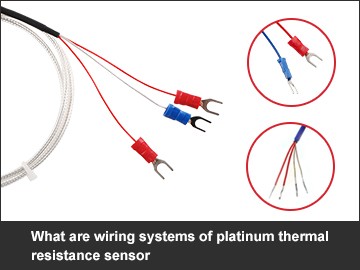What are wiring systems of platinum thermal resistance sensor
Platinum thermal resistance sensor is designed and manufactured using the basic principle that the resistance value of platinum wire changes with temperature changes. It is a primary element that converts temperature changes into resistance value changes. Usually, the resistance signal needs to be transmitted to the computer control device through the lead wire or On other disposable instruments.
There are three common wiring systems for platinum thermal resistance sensor in industry, and different wiring methods have different effects on the measurement results:
Two-wire system: the method of connecting a wire at each end of the thermal resistance to lead out the resistance signal is called two-wire system: this method of wiring is very simple, but due to the connection of the wire, there must be a wire resistance(r), the size of wire resistance and the material and length of the wire are related, so this wiring method is only suitable for occasions with low measurement accuracy.
Three-wire system: The method of connecting one lead at one end of the root of the thermal resistance and connecting two leads at the other end is called three-wire system. This method is usually used in conjunction with an electric bridge, which can better eliminate the influence of lead resistance. It is most commonly used in process control.
Four-wire system: the method of connecting two wires at the two ends of the root of the thermal resistance is called four-wire system, where two leads provide a constant current I for the thermal resistance, convert R into a voltage signal U, and then pass through the other two wires to lead U to the secondary instrument. It can be seen that this wiring method can completely eliminate the influence of the resistance of the lead, and is mainly used for high-precision temperature detection.
The relationship between the resistance of platinum thermal resistance sensor and temperature, that is, the indexing characteristics, is completely equivalent to the IEC standard, and it can be used to measure temperatures ranging from -200 to 850 ° C. However, the temperature range measured by different index numbers is slightly different, so we need to select the corresponding index number and wiring method according to the actual measurement temperature and accuracy requirements when selecting the platinum thermal resistance.






